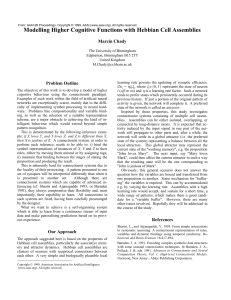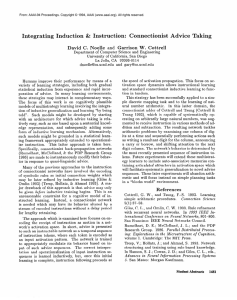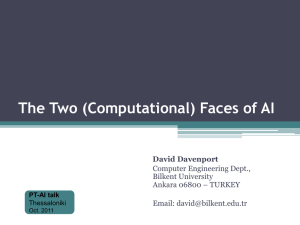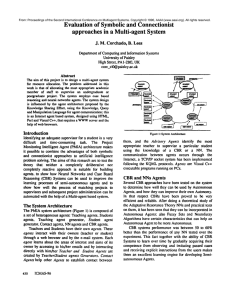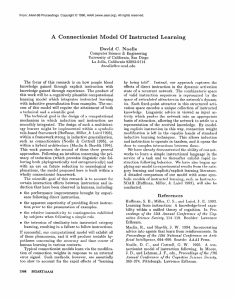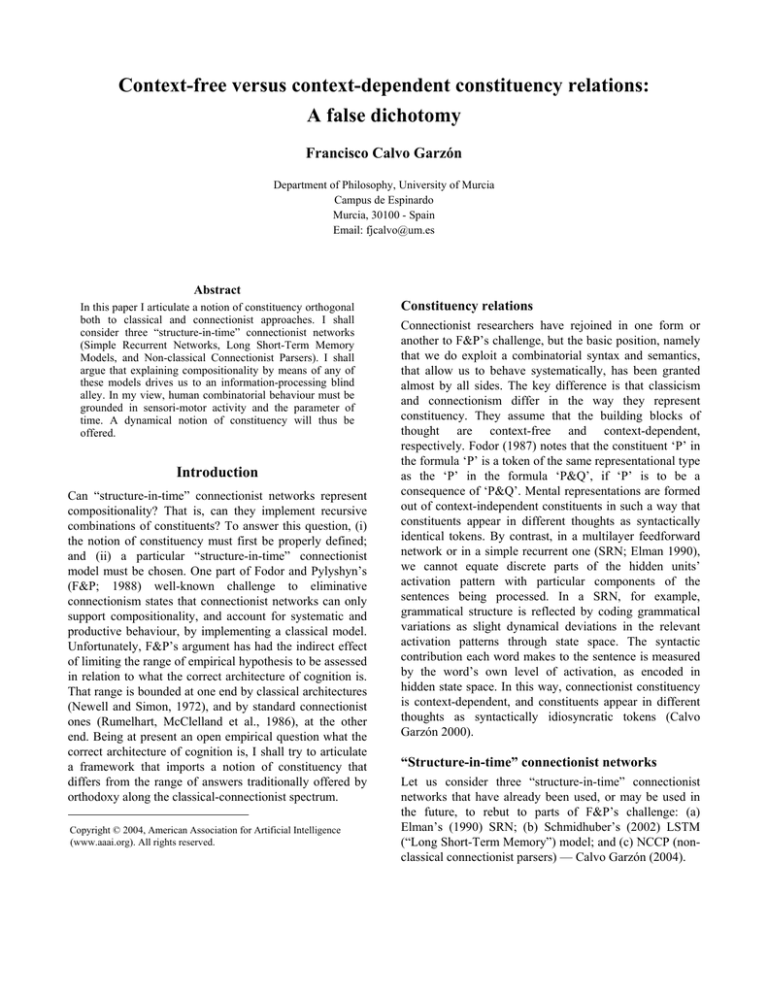
Context-free versus context-dependent constituency relations:
A false dichotomy
Francisco Calvo Garzón
Department of Philosophy, University of Murcia
Campus de Espinardo
Murcia, 30100 - Spain
Email: fjcalvo@um.es
Abstract
In this paper I articulate a notion of constituency orthogonal
both to classical and connectionist approaches. I shall
consider three “structure-in-time” connectionist networks
(Simple Recurrent Networks, Long Short-Term Memory
Models, and Non-classical Connectionist Parsers). I shall
argue that explaining compositionality by means of any of
these models drives us to an information-processing blind
alley. In my view, human combinatorial behaviour must be
grounded in sensori-motor activity and the parameter of
time. A dynamical notion of constituency will thus be
offered.
Introduction
Can “structure-in-time” connectionist networks represent
compositionality? That is, can they implement recursive
combinations of constituents? To answer this question, (i)
the notion of constituency must first be properly defined;
and (ii) a particular “structure-in-time” connectionist
model must be chosen. One part of Fodor and Pylyshyn’s
(F&P; 1988) well-known challenge to eliminative
connectionism states that connectionist networks can only
support compositionality, and account for systematic and
productive behaviour, by implementing a classical model.
Unfortunately, F&P’s argument has had the indirect effect
of limiting the range of empirical hypothesis to be assessed
in relation to what the correct architecture of cognition is.
That range is bounded at one end by classical architectures
(Newell and Simon, 1972), and by standard connectionist
ones (Rumelhart, McClelland et al., 1986), at the other
end. Being at present an open empirical question what the
correct architecture of cognition is, I shall try to articulate
a framework that imports a notion of constituency that
differs from the range of answers traditionally offered by
orthodoxy along the classical-connectionist spectrum.
Copyright © 2004, American Association for Artificial Intelligence
(www.aaai.org). All rights reserved.
Constituency relations
Connectionist researchers have rejoined in one form or
another to F&P’s challenge, but the basic position, namely
that we do exploit a combinatorial syntax and semantics,
that allow us to behave systematically, has been granted
almost by all sides. The key difference is that classicism
and connectionism differ in the way they represent
constituency. They assume that the building blocks of
thought are context-free and context-dependent,
respectively. Fodor (1987) notes that the constituent ‘P’ in
the formula ‘P’ is a token of the same representational type
as the ‘P’ in the formula ‘P&Q’, if ‘P’ is to be a
consequence of ‘P&Q’. Mental representations are formed
out of context-independent constituents in such a way that
constituents appear in different thoughts as syntactically
identical tokens. By contrast, in a multilayer feedforward
network or in a simple recurrent one (SRN; Elman 1990),
we cannot equate discrete parts of the hidden units’
activation pattern with particular components of the
sentences being processed. In a SRN, for example,
grammatical structure is reflected by coding grammatical
variations as slight dynamical deviations in the relevant
activation patterns through state space. The syntactic
contribution each word makes to the sentence is measured
by the word’s own level of activation, as encoded in
hidden state space. In this way, connectionist constituency
is context-dependent, and constituents appear in different
thoughts as syntactically idiosyncratic tokens (Calvo
Garzón 2000).
“Structure-in-time” connectionist networks
Let us consider three “structure-in-time” connectionist
networks that have already been used, or may be used in
the future, to rebut to parts of F&P’s challenge: (a)
Elman’s (1990) SRN; (b) Schmidhuber’s (2002) LSTM
(“Long Short-Term Memory”) model; and (c) NCCP (nonclassical connectionist parsers) — Calvo Garzón (2004).
Simple recurrent networks Elman (1998) trained a
network to answer a criticism, along the lines of F&P, put
forward by Hadley (1992), and Marcus (1998). The
challenge is to explain how connectionist networks can
account for strong systematicity; a sort of generalization in
which the network must generalize to previously
unencountered grammatical roles. Elman trained a SRN on
a corpus in which words had different probability of
occurrence in the grammar. Although ‘boy’ never
appeared in direct object position for any verb in the
training data set, the network does predict ‘boy’ as a direct
object after presentation of the verb ‘talk-to’. The reason is
that ‘boy’ has already been fed to the network during
training in other contexts together with other human
words—e.g., girl, man, woman. So, for example, only
human words appear in subject position with verbs such as
‘eat’, ‘give’, or ‘transfer’. On the other hand, neither ‘boy’
nor other human words appear in object position with
verbs such as ‘terrify’ or ‘chase’. In short, even though the
network never sees ‘boy’ in an object position, it is trained
on roles that ‘boy’ shares with other human words (more
than it does with other types of words). This “behaviourbased similarity” between ‘boy’ and other human words
(see Elman 1998, for the details) is what allows the SRN to
generalize to previously unencountered syntactic roles.
Given that the activation patterns for, say, ‘girl’, ‘man’, or
‘woman’ are very similar to the one encoding for ‘boy’,
there will be a high correlation between weight changes
and activation patterns for tokens of these word-types.
“Long Short-Term Memory” models Schmidhuber
(2002) offers a connectionist architecture called LSTM
(“Long Short-Term Memory”) as a model that manages to
solve one of SRNs weak points: namely, the fact that
SRNs’ short-term memory can sometimes be too short for
the sequential task in question. A LSTM model consists of
clusters of units arranged in the following way. A linear
recurrent unit (with a 1.0 weight recurrency loop) sums up
the incoming signals from surrounding non-linear units.
Clusters of such non-linear units with linear ones in the
middle join up to constitute the architecture of the network.
The critical point is that while the non-linear units allow
the network to keep track of non-adjacent statistical
dependencies, the linear units in between can maintain a
memory of any arbitrary number of time steps—see
Schmidhuber (2002) for the details.
Non-classical connectionist parsers Finally, elsewhere
(Calvo Garzón 2004) I have used the label “non-classical
connectionist parsers” (NCCP) to refer to the class of
models that have different combinations of pattern
associator/autoassociative memory/competitive network
topologies (Rolls and Treves 1998), with bi-directional
connectivity and inhibitory competition (kWTA), and that
employ combined Hebbian and activation-phase learning
algorithms (McClelland’s 1994 GenRec). Error-driven
learning makes use of an activation-phase algorithm that,
via bi-directional connectivity and symmetric weight
matrices, permits the network to alter the knowledge
acquired in the weights by computing the difference
between an initial phase where the networks activations are
interpreted as its “expectation” of what’s to happen, and a
later phase where the environment provides the output
response to be taken as the teaching signal. Unsupervised
Hebbian learning, on the other hand, makes its
contribution by representing in hidden space the first-order
correlational structure of the data pool. Combined Hebbian
and activation-phase learning drives “structure-in-time”
networks to a better performance on generalization than
the backpropagation algorithm does (O'Reilly and
Munakata 2000). Moreover, thanks to one-shot Hebbian
learning (Rolls and Treves 1998), a few event coocurrences can contribute to fast recall.
The information-processing blind alley
All (a), (b), and (c) networks can represent syntactic
structures in a purely exemplar-based fashion, avoiding the
exploitation of symbolic resources. The models employ
neither grammatical classical constituents, nor is the
processing sensitive to the syntax of such constituents. The
behaviour of the networks remains rooted in
representations
which
are
context-dependent.
Considerations, nevertheless, that have to do with some or
all of the above models should urge us to look for a
different framework. For one thing, LSTM models, for
example, fall short in terms of biological plausibility. Note
that the network can extend its short-term memory only
thanks to the exploitation of unbiological linear units. In
this respect, SRNs and NCCPs would have an advantage in
terms of full-fledged non-linearity. But, more importantly,
humans don’t behave the way LSTM networks do. We
simply don’t implement arbitrarily long sequential
behaviour. Forgetting is precisely part of the trick for
retrieving superposed context-dependent information. If
compositionality is to be explained, crucially, it will have
to depend on other sort of resources, than memory
resources per se.
Unfortunately, in my view, were we to account for
compositionality by means of models (a), (b), or (c) above,
we’d be in a blind alley (Calvo Garzón, forthcoming). The
classical/connectionist dichotomy that I’m calling into
question amounts to the context-free v. context-dependent
constituency relation dichotomy that the algebra v.
statistics debate in Cognitive Science involves. Syntactic
processing requires constituents to be context-free, and
classical syntactic computationalism is manipulation of
symbols according to algebraic rules. According to this
classical hypothesis, algebraic rules may correspond to
GOFAI algorithms or to any ecological form that respects
the syntax of context-free representations (e.g., Marcus
2001). Computations in connectionist networks, on the
other hand, have to do with vectorial transformations
(Churchland and Sejnowski 1992). Computationalism
amounts to manipulation of subsymbols according to
statistical rules. As we’ve seen, the difference is that
content in the connectionist guise is subsymbolic and
constituents are context-dependent. Granting this
landscape, the friends of classical orthodoxy will keep
searching for cognitive abilities that, defying statistical
explanations under the poverty of the stimulus lens,
embarrass their foes. Rule-following sceptics (Calvo and
Colunga 2003) will rejoin by finding ecological data that
(1) can be exploited statistically and (2) allow
connectionist networks to remain computationally
adequate. Put bluntly, the connectionist’s overall strategy
is to show that stimuli are not so poor after all!
It is noteworthy, however, that both hypotheses, the
classical and the connectionist, fall neatly within the
information-processing paradigm. The architecture of
cognition has been questioned, but assumptions about its
computational underpinnings remain unchallenged under
(a), (b), and (c) models. Perhaps we are stuck in a neverending dialectic of positing challenges to connectionism,
and then trying to account for them statistically, forever
and ever (see Peña et al. 2002; and Calvo Garzón, under
review, for an illustration of this dialectical sequel). In
view of this scenario, I contend, we may need to consider
turning to questions concerning the role that potential
contenders, such as Dynamic Systems Theory (DST)
(Thelen and Smith 1994) may play in the future.
Dynamic Systems Theory
Unlike information-processing-based frameworks, DST
tries to model and explain the behavior of concrete systems
by identifying them with sets of variables that change
continually over time. A dynamical system, in this way,
can be analyzed in terms of the differential equations that
contain the quantitative variables whose interdependencies
describe the laws that govern the behavior of the system.
DST has proved extremely useful in the physical sciences
(e.g., Kelso 1995; Thelen et al. 2002). Crucially, cognitive
activity cannot be accounted for without taking into
account the perceptual and motor apparatus that facilitates
in the first place the agent’s dealing with the external
world. The working hypothesis is that the same
mathematical toolkit of differential equations can be put to
the use of describing and explaining combinatorial
behaviour. My underlying assumption is thus that human
combinatorial behaviour must be grounded in sensorimotor activity and the parameter of time.
There is, however, a tension manifested in DST’s
attempt to put forward models of higher level forms of
cognition
and
its
commitment
to
respecting
neurophysiological, bodily, and environmental constraints.
That tension, in my view, can only be resolved by keeping
our dynamic modeling, ontologically speaking, at the level
of its pre-94 sensory-motor origins. The line of research
championed by Thelen, Smith and colleagues in motor
control primarily targeted symbol-based explanations of
motor activity. Those uneasy with the first steps of the
dynamic motor approach would argue that the level of
description of the systems was too abstract, failing thus to
throw light upon implementing physiological structures. In
my view, basic neuroscience should be able to understand
compositional behaviour non-computationally; that is, at
the neurophysiological level.
Constituency as basins of attraction
Granting this stance for argument’s sake, my proposal
involves the endorsement of a dynamical form of
constituency. Classical and connectionist constituents
would be replaced with dynamical basins of attraction. For
one thing, such an approach differs from connectionism in
that neural networks have traditionally tried to account for
higher-level phenomena, ignoring their ecological
underpinnings. The grounding (in Harnad’s 1990 sense) of
the subsymbols deployed by those networks is not
justified, becoming merely “thinner” symbols. But there
are more important differences. Connectionist networks
can be seen as universal function approximators (Hornik et
al. 1989). Universality which strictly computationally
speaking can be sold as a virtue, may also be seen as a
vice. Models (a), (b) and (c) above may be suspicious of
doing to much! (i.e., of being underconstrained). By
contrast, dynamical models, because of the exploitation of
constraints in terms of embeddiment and embodiment, do
not behave universally, but rather incorporate ecologicallygrounded parametric restrictions.
In this respect, DST constitutes an interesting departure
from orthodoxy. Given that the temporal dimension can be
processed implicitly by means of recurrency loops, some
researchers would be willing to interpret (a), (b) and (c) as
dynamical networks (cf. Port and van Gelder 1995; for a
review, see Elman 2004). Nevertheless, although important
progress has been made in understanding temporal changes
in SRNs (e.g., Rodríguez et al. 1999), connectionist theory
still hasn’t got an explanation of embodied real-time
dynamics. In my view, no clear-cut criterion in the market
allows us to decide exactly what it is that differentiates
connectionist networks from dynamical systems (although
see Spencer and Thelen 2003).
On the other hand, there’s no guarantee in connectionist
modelling that an optimal solution will be found for
several different corpora. However, this is not a problem
for dynamicism. Once we have the correct equations with
an adequate set of variables chosen, two different corpora
will be treated equally.
not because some external aspect remains intact, but rather
because whatever states happen to be critical for solving
compositionality, they are all reliable; those that remain
intact as well as those that do not. The picture I’m offering
is one in which constituents are not hidden states that we
manipulate, but rather states that change continuously as
they’re coupled with the environment.
Multicausality and environmental reliability
It may be argued that basins of attraction are nothing but
the constituents that Fodor and Pylyshyn demand, although
hidden in the dynamical jargon of bifurcations, stabilities,
and the like. The answer is “no”. As a matter of fact,
dynamical attractors cannot even be equated with
connectionist ones, since they are more idiosyncratic, in
the sense of being more rooted in the here-and-now.
Connectionist attractors are stable in that they imply a
higher level of abstraction as they lack real-time
embodiment. However, note that for the connectionist, the
fact that information gets recoded in hidden layers
idiosycratically is fully compatible with the positing of an
inner cognizer. Thus, whereas connectionist models put the
stress on the hidden space trajectories understood as
cognitive representational changes, dynamicism focuses on
the joint contribution of brain, body and environment and,
therefore, on multicausal instabilities. This should not be
interpreted merely as a difference in emphasis. Under both
the classical and the connectionist hypotheses,
compositionality requires information to be represented
within the system. For classicism, it is obviously so.
Regarding connectionism, Elman comments with regard to
model (a) above that “(the) fundamental suggestion of the
present proposal is to treat words as stimuli, whose
“meaning” lies in the causal effects they have on the
mental states.” (2004; emphasis added).
The present proposal implies a departure from Elman’s
perspective on two fronts: Dynamical embeddiment means
that the cognitive system can economize resources.
Information need not be present constantly within the
system. It’s already out there! Note that it’s easier for the
system to induce a certain degree of reliability in the
environment; reliability that can be couched in terms of
stability, for instance (although see below). On the other
hand, the emphasis should be placed not on the onedimensional cause-effect chain between input and output
within the system, but rather on endogenous plus
exogenous coupled multicausality.
A final caveat will help clarify a potential source of
misundertandings as to what dynamical constituency
implies. Although the emphasis of dynamicism is on the
stability of states of the world, it would be a mistake to
think of those states as the reason why enduring classical
or connectionist constituents are not needed. Cognition
must be explained without the resource of enduring states,
Acknowledgments
The author was supported by a Ramón y Cajal research
contract (Spanish Ministry of Science and Technology)
during the preparation of this manuscript. Thanks to Esther
Thelen and Josep Miró for helpful discussion.
References
Calvo Garzón, F. 2000. A Connectionist Defence of the
Inscrutability Thesis. Mind and Language 15:465-80.
Calvo Garzón, F. 2003. Connectionist Semantics and the
Collateral Information Challenge. Mind and Language
18:77-94.
Calvo Garzón, F. 2004. Non-classical Connectionism
Should Enter the Decathlon. Behavioral and Brain
Sciences 26(5):603-604.
Calvo Garzón, F. Rules, Similarity, and the InformationProcessing Blind Alley. Behavioral and Brain Sciences.
Forthcoming.
Calvo Garzón, F. Statistics can induce regularities in a
discontinuous speech stream. Under Review.
Calvo, F.; and Colunga, E. 2003. The Statistical Brain:
Reply to Marcus' The Algebraic Mind. In Proceedings to
the Twenty-Fifth Annual Conference of the Cognitive
Science Society, 210-215. Hillsdale, NJ.: Lawrence
Erlbaum Associates.
Churchland, P., and Sejnowski, T. 1992. The
Computational Brain. Cambridge, Mass.: MIT Press.
Elman, J.L. 1990. Finding Structure in Time. Cognitive
Science 14:179-211.
Elman, J.L. 1998. Generalization, Simple Recurrent
Networks, and the Emergence of Structure. In Proceedings
of the 20th Annual Conference of the Cognitive Science
Society. Mahwah, NJ.: Lawrence Erlbaum Assoc.
Elman, J.L. 2004. A Different View of the Mental
Lexicon. Trends in Cognitive Sciences 8:301-306.
Fodor, J. .1987. Psychosemantics. Cambridge, Mass.: MIT
Press.
Fodor, J.; and Pylyshyn, Z. 1988. Connectionism and
Cognitive Architecture: A Critical Analysis. Cognition
28:3-71.
Hadley, R.F. 1992. Compositionality and Systematicity in
Connectionist Language Learning. In Proceedings of the
Fourteenth Annual Conference of the Cognitive Science
Society. Mahwah, NJ.: Lawrence Erlbaum Assoc.
Harnad, S. 1990. The Symbol Grounding Problem.
Physica D 42:335–346.
Hornick et al. 1989. Multilayer Feedforward Networks are
Universal Approximators. Neural Networks 2: 359-366.
Kelso, J.A.S. 1995. Dynamic Patterns: The SelfOrganization of Brain and Behavior. Cambridge, Mass.:
MIT Press.
Marcus, G. 1998. Symposium on Cognitive Architecture:
The Algebraic Mind. In Proceedings of the 20th Annual
Conference of the Cognitive Science Society. Mahway, NJ:
Lawrence Erlbaum Associates.
Marcus, G. 2001. The Algebraic Mind: Integrating
Connectionism and Cognitive Science. Cambridge, Mass.:
MIT Press.
McClelland, J. 1994. The Interaction of Natura and
Nurture in Development: A Parallel Distributed Processing
Perspective. In Current Advances in Psychological
Science. eds. Bertelson, P., Eelen, P., and D'Ydewalle, G.
Lawrence Erlbaum Associates.
Newell, A., and Simon, H. 1972. Human Problem Solving.
Englewood Cliffs, NJ.: Prentice Hall.
O’Reilly, R. 1998. Six Principles for Biologically Based
Computational Models of Cortical Cognition. Trends in
Cognitive Sciences 2:455–462.
O’Reilly, R., and Munakata, Y. 2000. Computational
Explorations in Cognitive Neuroscience. Cambridge,
Mass.: MIT Press.
Peña, M.; Bonatti, L.; Nespor, M.; and Mehler, J. 2002.
Signal-Driven computations in Speech Processing. Science
298:604-607.
Port, R., and van Gelder, T. 1995. Mind as Motion.
Cambridge, Mass.: MIT Press.
Rodriguez P.; Wiles, J.; and Elman, J.L. 1999. A Recurrent
Neural Network That Learns to Count. Connection Science
11:5-40.
Rolls, E.T., and Treves, A. 1998. Neural Networks and
Brain Function. Oxford: Oxford University Press.
Rumelhart, D.E., McClelland, J.L., et al. 1986. Parallel
Distributed Processing. Cambridge, Mass.: MIT Press.
Schmidhuber, J.; Gers, F.; and Eck. D. 2002. Learning
Nonregular Languages: A Comparison of Simple
Recurrent Networks and LSTM. Neural Computation
14(9):2039- 2041.
Thelen, E., and Smith, L. B. 1994. A Dynamics Systems
Approach to the Development of Perception and Action.
Cambridge, Mass.: MIT Press.
Thelen, E.; Schöner, G.; Scheier, C.; and Smith, L. 2001.
The Dynamics of Embodiment: A Field Theory of Infant
Perseverative Reaching. Behavioral and Brain Sciences
24:1-86.

